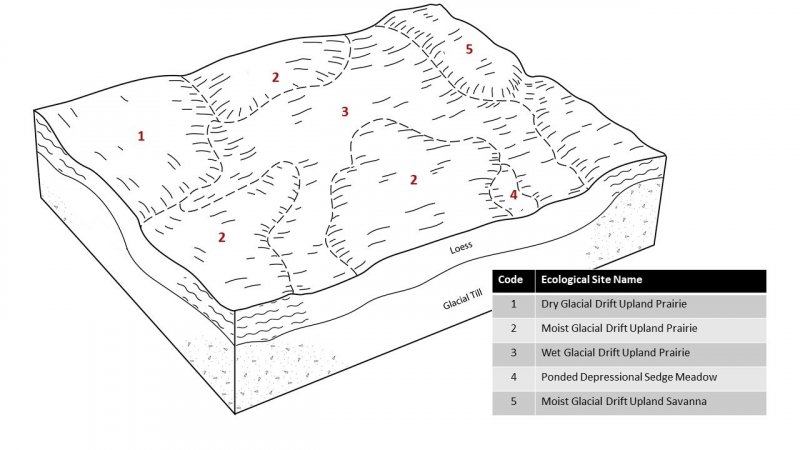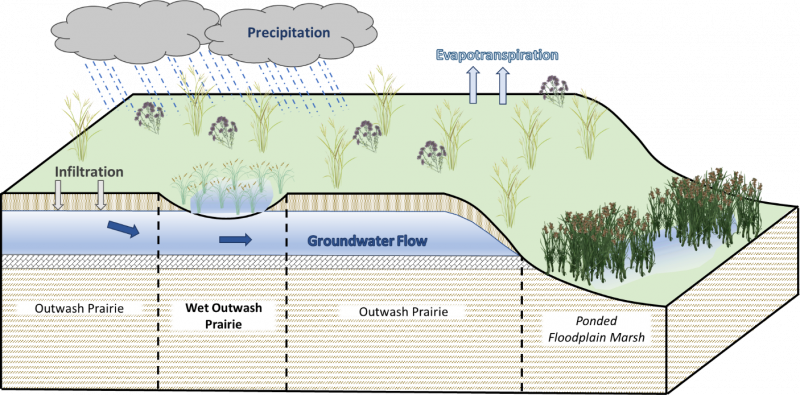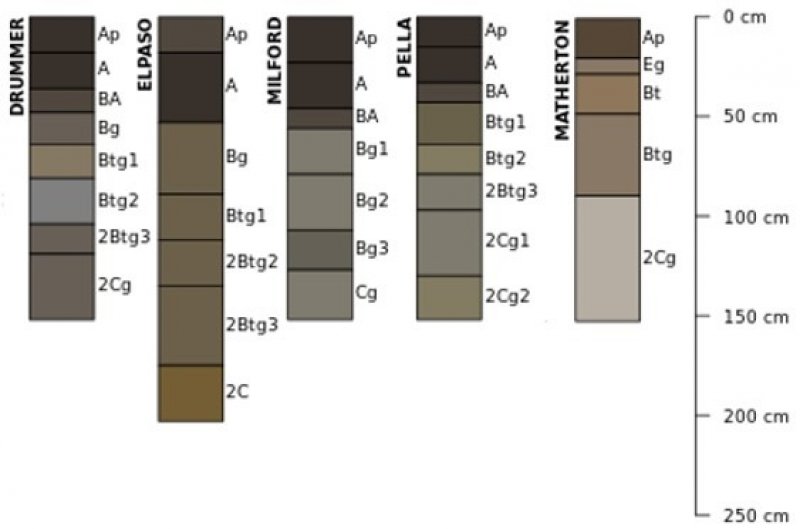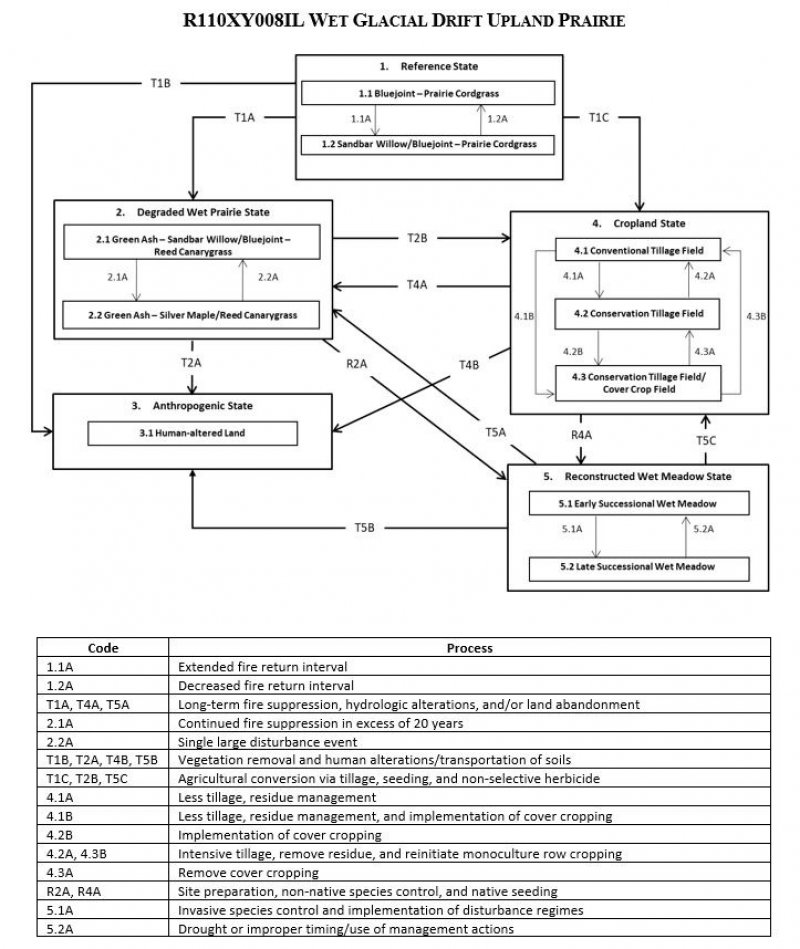Ecological dynamics
The information in this Ecological Site Description, including the state-and-transition model (STM), was developed based on historical data, current field data, professional experience, and a review of the scientific literature. As a result, all possible scenarios or plant species may not be included. Key indicator plant species, disturbances, and ecological processes are described to inform land management decisions.
The MLRA lies within the tallgrass prairie ecosystem of the Midwest, but a variety of environmental and edaphic factors resulted in landscape that historically supported prairies, savannas, forests, and various wetlands. Wet Glacial Drift Upland Prairies form an aspect of this vegetative continuum. This ecological site occurs on uplands on poorly-drained soils. Species characteristic of this ecological site consist of hydrophytic herbaceous vegetation.
Fire is a critical disturbance factor that maintains Wet Glacial Drift Upland Prairies. Fire intensity typically consisted of periodic, low-intensity surface fires occurring every 2 to 5 years (LANDFIRE 2009). Ignition sources included summertime lightning strikes from convective storms and bimodal, human ignitions during the spring and fall seasons. Native Americans regularly set fires to improve sight lines for hunting, driving large game, improving grazing and browsing habitat, agricultural clearing, and enhancing vital ethnobotanical plants (Barrett 1980).
Saturated soil conditions and herbivory by native ungulates have also played a role in shaping this ecological site. The high soil moisture conditions have favored the proliferation of plant species tolerant of such conditions. The high-water tables prevent many woody species from establishing, thus maintaining the prairie structure. Grazing also likely contributed to woody species reduction (LANDFIRE 2009). When coupled with fire, saturated soils and herbivory can further delay the establishment of woody vegetation (Pyne et al. 1996).
Today, Wet Glacial Drift Upland Prairies have been greatly reduced as most areas have been converted to agricultural production with corn (Zea mays L.) and soybeans (Glycine max (L.) Merr.) the dominant crops grown. Some areas may have been converted to other human-modified landscapes. Remnants that do exist show evidence of indirect anthropogenic influences from fire suppression, subsurface drainage, and non-native species invasion. A return to the historic plant community may not be possible following extensive land modification, but long-term conservation agriculture or prairie reconstruction efforts can help to restore some biotic diversity and ecological function. The state-and-transition model that follows provides a detailed description of each state, community phase, pathway, and transition. This model is based on available experimental research, field observations, literature reviews, professional consensus, and interpretations.
State 1
Reference State
The reference plant community is categorized as a wet tallgrass prairie community, dominated by hydrophytic herbaceous vegetation. The two community phases within the reference state are dependent on periodic fire. The intensity and frequency alter species composition, cover, and extent, while regular fire intervals keep woody species from dominating. Soil saturation and native mammal grazing have more localized impacts in the reference phases, but do contribute to overall species composition, diversity, cover, and productivity.
Community 1.1
Bluejoint - Prairie Cordgrass
Sites in this reference community phase are dominated by a mix of hydrophytic grasses, sedges, and forbs. Vegetative cover is continuous (95 to 100 percent) and plants can reach heights between 3 and 6 feet tall (NatureServe 2018). Bluejoint, prairie cordgrass, and various sedges are the dominant monocots on the site. Characteristic forbs can include common boneset (Eupatorium perfoliatum L.), Virginia iris (Iris virginica L.), American water horehound (Lycopus americanus Muhl. ex W.P.C. Barton), and hemlock waterparsnip (Sium suave Walter) (White and Madany 1978; NatureServe 2018). Replacement fires every 2 to 5 years characterize the fire regime, maintaining this reference plant community. An extended fire return interval will shift the community to phase 1.2 (LANDFIRE 2009).
Community 1.2
Sandbar Willow/Bluejoint - Prairie Cordgrass
This reference community phase represents a successional shift from an extended fire return interval. Grasses, sedges, and forbs are still prominent, but scattered shrubs – such as sandbar willow (Salix interior Rowlee) – begin to develop and mature (Bowles and Jones 2004). Low intensity fires will maintain this community phase, but a hot replacement fire will shift the site back to community phase 1.1 (LANDFIRE 2009).
Pathway 1.1A
Community 1.1 to 1.2
Natural succession due to an extended fire return interval.
Pathway 1.2A
Community 1.2 to 1.1
Hot replacement fire every 1 to 3 years.
State 2
Degraded Wet Prairie State
Long-term fire suppression and landscape hydrologic alterations can transition the reference wet tallgrass prairie community into a woody-invaded state. This state is evidenced by a well-developed shrub layer and sparse trees (LANDFIRE 2009). Proximity to lands that have been altered provide opportunities for non-native invasive species to readily colonize this state, thereby reducing the native biodiversity and changing the vegetative community.
Community 2.1
Green Ash - Sandbar Willow/Bluejoint - Reed Canarygrass
This community phase represents the early stages of long-term fire-suppression. In as little as six fire-free years, the prairie can be disrupted and succeeded by woody shrubs. Native trees – e.g., green ash (Fraxinus pennsylvanica Marshall), silver maple (Acer saccharinum L.), elm (Ulmus L.) – and shrubs can form dense thickets with cover reaching up to 30 percent and plant heights as tall as 9 feet (LANDFIRE 2009). Some native prairie plants will persist, but non-native herbaceous species, including reed canarygrass (Phalaris arundinacea L.), smooth brome (Bromus inermis Leyss.), Kentucky bluegrass (Poa pratensis L.), and redtop (Agrostis gigantea Roth) can begin to encroach from adjacent, disturbed sites.
Community 2.2
Green Ash - Silver Maple/Reed Canarygrass
Sites falling into this community phase have scattered trees beginning to mature in the continued absence of fire and reduced water table.
Pathway 2.1A
Community 2.1 to 2.2
Continued fire suppression in excess of 20 years.
Pathway 2.2A
Community 2.2 to 2.1
Single large disturbance event such as selective removal of some woody species.
State 3
Anthropogenic State
The anthropogenic state occurs when the reference state is cleared and developed for human use and inhabitation, such as for commercial and housing developments, landfills, parks, golf courses, cemeteries, earthen spoils, etc. The native vegetation has been removed and soils have either been altered in place (e.g. cemeteries) or transported from one location to another (e.g. housing developments). Most of the soils in this state have 50 to 100 cm of overburden on top of the natural soil. This natural material can be determined by observing a buried surface horizon or the unaltered subsoil, till, or lacustrine parent materials. This state is generally considered permanent.
Community 3.1
Human-altered land
Sites in this community phase have had the native plant community removed and soils heavily re-worked in support of human development projects.
State 4
Cropland State
The continuous use of tillage, row-crop planting, chemicals (i.e., herbicides, fertilizers, etc.), and subsurface tile drainage has effectively eliminated the reference community and many of its natural ecological functions in favor of crop production. Corn and soybeans are the dominant crops for the site, and common wheat (Triticum aestivum L.) and alfalfa (Medicago sativa L.) may be rotated periodically. These areas are likely to remain in crop production for the foreseeable future.
Community 4.1
Conventional Tillage Field
Sites in this community phase typically consist of monoculture row-cropping maintained by conventional tillage practices. They are cropped in either continuous corn or corn-soybean rotations. The frequent use of deep tillage, low crop diversity, and bare soil conditions during the non-growing season negatively impacts soil health. Under these practices, soil aggregation is reduced or destroyed, soil organic matter is reduced, erosion and runoff are increased, and infiltration is decreased, which can ultimately lead to undesirable changes in the hydrology of the watershed (Tomer et al. 2005).
Community 4.2
Conservation Tillage Field
This community phase is characterized by rotational crop production that utilizes various conservation tillage methods to promote soil health and reduce erosion. Conservation tillage methods include strip-till, ridge-till, vertical-till, or no-till planting systems. Strip-till keeps seedbed preparation to narrow bands less than one-third the width of the row where crop residue and soil consolidation are left undisturbed in-between seedbed areas. Strip-till planting may be completed in the fall and nutrient application either occurs simultaneously or at the time of planting. Ridge-till uses specialized equipment to create ridges in the seedbed and vegetative residue is left on the surface in between the ridges. Weeds are controlled with herbicides and/or cultivation, seedbed ridges are rebuilt during cultivation, and soils are left undisturbed from harvest to planting. Vertical-till systems employ machinery that lightly tills the soil and cuts up crop residue, mixing some of the residue into the top few inches of the soil while leaving a large portion on the surface. No-till management is the most conservative, disturbing soils only at the time of planting and fertilizer application. Compared to conventional tillage systems, conservation tillage methods can improve soil ecosystem function by reducing soil erosion, increasing organic matter and water availability, improving water quality, and reducing soil compaction.
Community 4.3
Conservation Tillage Field/Alternative Crop Field
This community phase applies conservation tillage methods as described above as well as adds cover crop practices. Cover crops typically include nitrogen-fixing species (e.g., legumes), small grains (e.g., rye, wheat, oats), or forage covers (e.g., turnips, radishes, rapeseed). The addition of cover crops not only adds plant diversity but also promotes soil health by reducing soil erosion, limiting nitrogen leaching, suppressing weeds, increasing soil organic matter, and improving the overall soil ecosystem. In the case of small grain cover crops, surface cover and water infiltration are increased, while forage covers can be used to graze livestock or support local wildlife. Of the three community phases for this state, this phase promotes the greatest soil sustainability and improves ecological functioning within a cropland system.
Pathway 4.1A
Community 4.1 to 4.2
Tillage operations are greatly reduced, crop rotation occurs on a regular interval, and crop residue remains on the soil surface.
Pathway 4.1B
Community 4.1 to 4.3
Tillage operations are greatly reduced or eliminated, crop rotation occurs on a regular interval, crop residue remains on the soil surface, and cover crops are planted following crop harvest.
Pathway 4.2A
Community 4.2 to 4.1
Intensive tillage is utilized, and monoculture row-cropping is established.
Pathway 4.2B
Community 4.2 to 4.3
Cover crops are implemented to minimize soil erosion.
Pathway 4.3B
Community 4.3 to 4.1
Intensive tillage is utilized, cover crop practices are abandoned, monoculture row-cropping is established, and crop rotation is reduced or eliminated.
Pathway 4.3A
Community 4.3 to 4.2
Cover crop practices are abandoned.
State 5
Reconstructed Wet Meadow State
Wet meadow habitats provide multiple ecosystem services including flood abatement, water quality improvement, and biodiversity support. However, many wet meadow communities have been stressed from watershed-scale changes in hydrology or eliminated as a result of type conversions to agricultural production, thereby significantly reducing these services (Zedler 2003). The extensive alterations of lands adjacent to Wet Glacial Drift Upland Prairies may not allow for restoration back to the historic reference condition. However, ecological reconstruction can aim to aid the recovery of degraded, damaged or destroyed functions. A successful reconstruction will have the ability to structurally and functionally sustain itself, demonstrate resilience to the natural ranges of stress and disturbance, and create and maintain positive biotic and abiotic interactions (SER 2002; Mitsch and Jørgensen 2004).
Community 5.1
Early Successional Wet Meadow
This community phase represents the early community assembly from wet meadow reconstruction and is highly dependent on seed viability, hydroperiod, soil organic matter content, and site preparation. Successful establishment of native vegetation can be maximized by utilizing genotypes adapted to the environmental location, ensuring soil moisture is saturated at the time of seeding, and improving the water holding capacity and fertility of the soil (Mitsch and Gosselink 2007). In addition, suppression and removal of non-native species is essential for reducing competition (Perry and Galatowitsch 2003).
Community 5.2
Late Successional Wet Meadow
Appropriately timed disturbance regimes (e.g., hydroperiod, prescribed fire) and nutrient management applied to the early successional community phase can help increase the species richness, pushing the site into a late successional community phase over time (Mitsch and Gosselink 2007).
Pathway 5.1A
Community 5.1 to 5.2
Maintenance of proper hydrology and nutrient balances in line with a developed wetland management plan.
Pathway 5.2A
Community 5.2 to 5.1
Reconstruction experiences a setback from extreme weather event or improper timing of management actions.
Transition T1A
State 1 to 2
Long-term fire suppression and hydrologic alterations transition the site to the degraded wet prairie state (2).
Transition T1B
State 1 to 3
Vegetation removal and human alterations/transportation of soils transitions the site to the anthropogenic state (3).
Transition T1C
State 1 to 4
Installation of drain tiles, seeding of agricultural crops, and non-selective herbicide transition the site to the cropland state (4).
Transition T2A
State 2 to 3
Vegetation removal and human alterations/transportation of soils transitions the site to the anthropogenic state (3).
Transition T2B
State 2 to 4
Installation of drain tiles, seeding of agricultural crops, and non-selective herbicide transition this site to the cropland state (4).
Restoration pathway R2A
State 2 to 5
Site preparation, invasive species control, and seeding native species transition this site to the reconstructed wet meadow state (5).
Transition T4A
State 4 to 2
Agricultural production abandoned and left fallow; natural succession by opportunistic species transition this site to the degraded wet prairie state (2).
Transition T4B
State 4 to 3
Vegetation removal and human alterations/transportation of soils transitions the site to the anthropogenic state (3).
Restoration pathway R4A
State 4 to 5
Hydroperiod restoration, site preparation, non-native species control and seeding native species transition this site to the reconstructed wet meadow state (5).
Transition T5A
State 5 to 2
Land is abandoned and left fallow; natural succession by opportunistic species transition this site to the degraded wet prairie state (2).
Transition T5B
State 5 to 3
Vegetation removal and human alterations/transportation of soils transitions the site to the anthropogenic state (3).
Transition T5C
State 5 to 4
Installation of drain tiles, seeding of agricultural crops, and non-selective herbicide transition the site to the cropland state (4).





